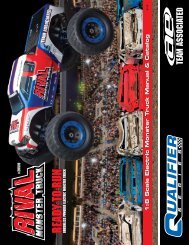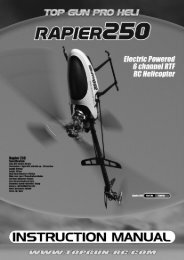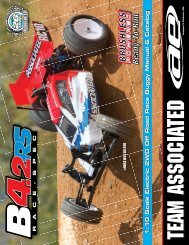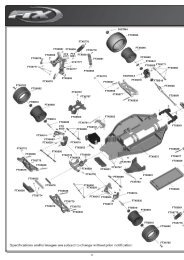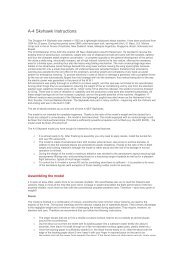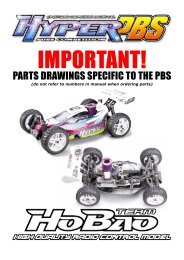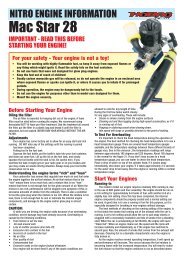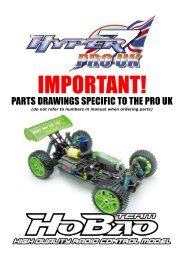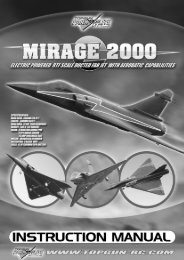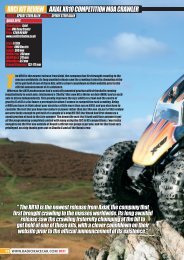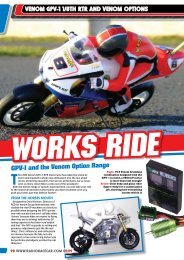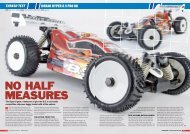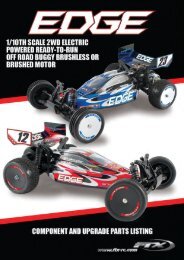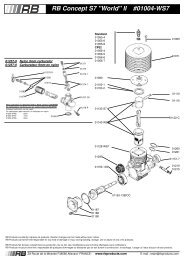Hyper 21 3-Port - CML Distribution
Hyper 21 3-Port - CML Distribution
Hyper 21 3-Port - CML Distribution
Create successful ePaper yourself
Turn your PDF publications into a flip-book with our unique Google optimized e-Paper software.
engine up again. Add more fuel. Start it back up and run the second tank of<br />
fuel. Again allow the engine to cool before starting it up again.<br />
The key to breaking in your engine is patience. During the break in<br />
period , your engine may appear to malfunction with problems such as<br />
stalling, inconsistent performance, and fouling out glow plugs. Don’t give<br />
up. These are just a few things you may go through during the break in<br />
period. Just keep it running, apply the throttle on and off as smoothly as<br />
you can. Sudden bursts or quick releases of the throttle can stall your<br />
engine. Soon after break in your patience will pay off with a well running<br />
engine. The performance level of the<br />
engine will be limited by the “rich’ fuel mixture which you will use all<br />
during the break-in process. Once the engine is fully broken-in the mixture<br />
can be “leaned out,” and speed and acceleration will increase. Because of<br />
the rich fuel mixture and the wearing of the new parts, deposits will form<br />
on the glow plug causing it to fail. Expect to replace the glow plug during<br />
the break in period, and definitely when the engine is fully broken in and<br />
the fuel mixture is leaned out.<br />
Setting Engine for Normal<br />
Tuning High Speed<br />
As you approach the first 6-8 tanks running you can start to<br />
GRADUALLY adjust you engine for normal performance. PLEASE NOTE any<br />
adjustments need to be very small at 1/8th turn increments. You can then<br />
begin adjusting the fuel mixture to maximize performance for your driving<br />
needs. To lean turn the main fuel control needle in a clockwise direction.<br />
This will allow the car to pull away faster and more cleanly, without<br />
hesitation and increase the top speed. There should however still be a<br />
noticeable smoke trail.<br />
If the main needle is screwed in too far thus allowing the engine to run<br />
too lean, it will seem to run strong at first, but will bog, hesitate,<br />
or stall when running at high speed. The engine will also rapidly<br />
overheat when the setting is too lean. This is because fuel includes<br />
lubrication, and that lubrication is inadequate when the setting is too lean.<br />
CHECK THE ENGINE TEMPERATURE OFTEN AS YOU LEAN THE MIXTURE. DO<br />
NOT LET THE ENGINE OVERHEAT. You should always see smoke coming<br />
from the exhaust.<br />
At the optimum setting, the engine will clean out; have a strongsounding,<br />
high-pitched whine at full speed; and there will be a thin trail of<br />
whitish smoke coming from the exhaust. It is always better to set the<br />
engine a little rich rather than too lean.<br />
If the engine stalls on acceleration, begins to bog or slow down at full<br />
throttle, or if there is a reduction in exhaust smoke, then the engine is<br />
running too lean. Immediately turn the high speed mixture screw<br />
counterclockwise 1/4 of a turn and operate the car at medium speeds for 1<br />
to 2 minutes to allow the engine to cool.<br />
Tuning Low Speed<br />
The low-speed mixture affects how the engine will perform in the low<br />
to mid range rpms. Turning the<br />
low-speed needle clockwise will<br />
lean the mixture. As with the highspeed<br />
mixture, leaning the lowspeed<br />
mixture increases<br />
performance. Again, if the mixture<br />
here is set too lean, the engine<br />
may be starved for lubrication in<br />
the lowand mid-rpm ranges, thus<br />
causing overheating and<br />
excessive engine wear.<br />
Perform the following test to<br />
determine if the low speed<br />
mixture is set correctly. With the engine warm and running, allow it to idle<br />
for approximately 15 seconds. Now quickly apply throttle and note the<br />
performance. If the engine bogs, accelerates erratically, and a large puff of<br />
blue smokes emitted, then the low speed mixture is too rich. Turn the lowspeed<br />
screw clockwise 1/8 of a turn. If the engine speeds up for a moment<br />
then bogs, hesitates, or stalls,<br />
then the low speed mixture is too<br />
lean. Turn the screw<br />
counterclockwise 1/8 of a turn.<br />
Adjust the mixture screws in 1/8<br />
of a turn increments, wait 15<br />
seconds, and retest after each<br />
change. Adjust for the best<br />
acceleration without the car<br />
stalling.<br />
Care and Maintenance<br />
When you are finished racing<br />
IDLE<br />
ADJUSTMENT<br />
LOW SPEED<br />
ADJUSTMENT<br />
HIGH SPEED<br />
ADJUSTMENT<br />
for the day, drain the fuel tank. Afterwards, energize the<br />
glow plug with your glow plug starter and try to restart<br />
the engine in order to burn off any fuel that may<br />
remain inside the engine. Repeat this procedure<br />
until the engine fails to fire. Try to eject residue<br />
while the engine is still warm. Finally, inject some<br />
corrosion inhibiting oil, and rotate the engine to<br />
distribute the oil to all the working parts. Do not,<br />
however, inject the oil into the carburetor, for it may cause<br />
the O-rings inside to deteriorate. When cleaning the exterior of<br />
the engine, use WD-40. Do not use gasoline or any solvents<br />
that might damage the silicone fuel tubing.<br />
Cleaning the air filter. When the air filter starts to get dirty,<br />
do the following steps:<br />
Step 1. Clean the foam with fuel. Do this by pouring a little fuel<br />
in a small can and kneading the filter in the fuel. When<br />
it looks cleaner, then dispose of the fuel.<br />
Step 2. Dry the filter. Squeeze out the fuel with a paper towel<br />
until it’s dry.<br />
Step 3. Apply Associated’s #7710 Foam Pre-Filter Treatment to<br />
help keep the dirt out. Dab the treatment all around the<br />
filter, put the filter in a plastic sandwich bag, and knead it until the<br />
filter is saturated, but not soaked.<br />
Troubleshooting<br />
Glow Plug Problems<br />
The glow plug in your engine is an inexpensive consumable item which<br />
must be replaced periodically to maintain peak performance and starting<br />
ease. Most often, any starting problems or erratic performance can be<br />
traced back to the glow plug. The glow plug should also be checked if the<br />
engine’s acceleration and top speed performance suddenly becomes flat.<br />
The only sure way to test for a faulty glow plug is simply install a new one<br />
to see if the problem goes away. Remove the plug from the cylinder head<br />
with a 5/16” nut driver. Make sure there is no dirt or debris on top of the<br />
head which could fall into the engine. Do not loose the copper gasket<br />
which seals the glow plug. Touch the glow plug to the contacts of the glow<br />
plug starter. All of the coils should glow white. Sometimes the first few<br />
coils will not glow while the rest are bright, most likely indicating a bad<br />
plug. If the glow is dim orange, then the glow starter battery should be<br />
replaced or recharged.<br />
At the high rpm that the engines operate only a top quality plug will cut<br />
the mustard. Therefore we recommend the use of either McCoy MC9 or<br />
RB #6 plugs.<br />
Fuel Mixture<br />
The fuel mixture is the largest variable you have to control while<br />
operating your engine.<br />
Fuel brand, ambient temperature, and humidity all effect how your<br />
mixture should be set. If the engine runs great one day but runs rich or<br />
lean the next day, it is probably the result of a change in the air quality and<br />
temperature. This should be expected and adjusted for.<br />
Although there are many fuels on the market, very few are designed to<br />
perform and protect your engine at the likes of 35,000rpm that some of our<br />
engines can attain. It is with this fact in mind, and our own in house testing<br />
that we ONLY RECOMMEND the following fuels:<br />
Byron RACE Gen2, Byron RACE Gen2<br />
RTR and Model Technics Dynaglow.<br />
Keep between 10 and 20% nitromethene<br />
content for running and first use. The single<br />
most popular reason for engine failure or<br />
unreliability is poor or wrong fuel. These<br />
fuels have been tested with our engines<br />
and we are confident of their<br />
performance.<br />
OTHER FUELS MAY WORK<br />
WITH OTHER ENGINES BUT<br />
THE FUELS LISTED WORK BEST<br />
WITH THESE ENGINES. FAILURE<br />
TO KEEP TO THESE FUELS MAY<br />
RESULT IN DAMAGE OR<br />
REDUCED PERFORMANCE AND<br />
VOID ANY WARRANTY CLAIMS.



